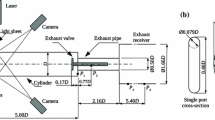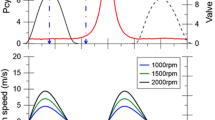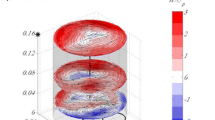Abstract
The turbulent and swirling flow of a uniflow-scavenged two-stroke engine cylinder is investigated using a scale model with a static geometry and a transparent cylinder. The swirl is generated by 30 equally spaced ports with angles of 0°, 10°, 20°, and 30°. A detailed characterization of the flow field is performed using stereoscopic particle image velocimetry. Mean fields are calculated using both a fixed coordinate system and a coordinate system based on the instantaneous flow topology. Time-resolved measurements of axial velocity are performed with laser Doppler anemometry, and power spectra are calculated in order to determine vortex core precession frequencies. The results show a very different flow dynamics for cases with weak and strong swirl. In the strongly swirling cases, a vortex breakdown is observed. Downstream of the breakdown, the vortex becomes highly concentrated and the vortex core precesses around the exhaust valve, resulting in an axial suction effect at the vortex center. Mean fields based on the instantaneous flow topology are shown to be more representative than mean fields based on a fixed coordinate system in cases with significant variations in the swirl center location.














Similar content being viewed by others
References
Albrecht HE, Damaschke N, Borys M, Tropea C (2003) Laser Doppler and phase Doppler measurement techniques. Springer, Berlin
Alekseenko SV, Koubin PA, Okulov VL, Shtork SI (1999) Helical vortices in swirl flow. J Fluid Mech 382:195–243
Benjamin TB (1962) Theory of the vortex breakdown phenomenon. J Fluid Mech 14(4):593–629
Craft T, Iacovides H, Launder B, Zacharos A (2008) Some swirling-flow challenges for turbulent CFD. Flow, Turbul Combust 80:419–434
Dedeoglu N (1990) Improvement of mixture formation in a uniflow-scavenged two-stroke engine. SAE Tech Paper Ser Paper No. 901536
Escudier MP, Keller JJ (1985) Recirculation in swirling flow: a manifestation of vortex breakdown. AIAA J 23(1):111–116
Escudier MP, Bornstein J, Maxworthy T (1982) The dynamics of confined vortices. Proc R Soc Lond A 382:335–350
Escudier MP, Nickson AK, Poole RJ (2006) Influence of outlet geometry on strongly swirling turbulent flow through a circular tube. Phys Fluids 18:125103
Gupta AK, Lilley DG, Syred N (1984) Swirl flows. Abacus Press, Tunbridge Wells
Haider S, Schnipper T, Obeidat A, Meyer KE, Okulov VL, Mayer S, Walther JH (2012) PIV study of the effect of piston position on the in-cylinder swirling flow during the scavenging process in large two-stroke marine diesel engines. J Mar Sci Tech accepted
Holman JP, Moore GD (1961) An experimental study of vortex chamber flow. J Basic Eng 83(4):632–636
Huang RF, Tsai FC (2001) Observations of swirling flows behind circular disks. AIAA J 39(6):1006–1112
Ingvorsen KM, Meyer KE, Schnipper T, Walther JH, Mayer S (2012) Swirling flow in model of large two-stroke diesel engine. In: 16th international symposium on applications of laser techniques to fluid mechanics, Lisbon, Portugal
Litke B (1999) The influence of inlet angles in inlet ports on the scavenging process in two-stroke uniflow-scavenged engine. Mar Tech III 45:247–252
Mattner TW, Joubert PN, Chong MS (2002) Vortical flow. Part 1. Flow through a constant-diameter pipe. J Fluid Mech 463:259–291
Nakagawa H, Kato S, Tateishi M, Adachi T, Tsujimura H, Nakashima M (1990) Airflow in the cylinder of a 2-stoke cycle uniform scavenging diesel engine during compression stroke. Jpn Soc Mech Eng 33(3):591–598
Nishimoto K, Kamimoto T (1984) A study on the influence of inlet angle and Reynolds number on the flow-pattern of uniflow scavenging air. SAE Tech Paper Ser 93(4):4788–4797, Paper No. 841056
Ohigashi S, Kashiwada Y, Achiwa J (1960) Scavenging the 2-stroke engine—effect of inlet port-angle on scavenging process of a through scavenging system. Jpn Soc Mech Eng 3(9):130–136
Percival WH (1955) Method of scavenging analysis for 2-stroke-cycle diesel cylinders. SAE Trans 63:737–751
Raffel M, Willert CE, Wereley ST, Kompenhans J (2007) Particle image velocimetry. A practical guide, 2nd edn. Springer, Berlin
Ruith MR, Chen P, Meiburg E, Maxworthy T (2003) Three-dimensional vortex breakdown in swirling jets and wakes: direct numerical simulation. J Fluid Mech 486:331–378
Sanborn D, Dedeoglu N (1988) Investigation on scavenging of two-stroke engines. SAE Tech Paper Ser Paper No. 881264
Sarpkaya T (1971) On stationary and travelling vortex breakdowns. J Fluid Mech 45(3):545–559
Schweitzer PH (1949) Scavenging of two-stroke cycle diesel engines. Macmillan Publishing Company, London
Sher E, Hossain I, Zhang Q, Winterbone DE (1991) Calculation and measurements in the cylinder of a two-stroke uniflow-scavenged engine under steady flow conditions. Exp Therm Fluid Sci 4:418–431
Sørensen JN, Naumov I, Mikkelsen R (2006) Experimental investigation of three-dimensional flow instabilities in a rotating lid-driven cavity. Exp Fluids 41:425–440
Steenbergen W, Voskamp J (1998) The rate of decay of swirl in turbulent pipe flow. Flow Meas Instrum 9(2):67–78
Sung NW, Patterson DJ (1982) Air motion in a two stroke engine cylinder—the effects of exhaust geometry. SAE Trans pp 2534–2544, Paper No. 820751
Velte CM, George WK (2010) Efficient estimation of burst-mode LDA power spectra. In: 15th international symposium on applications of laser techniques to fluid mechanics, Lisbon, Portugal, Paper No. 1652
Wakuri Y, Ono S, Kido H, Takasaki K (1981) An experimental study on the exhaust smoke of a diesel engine with variable angle swirler. Bull Jpn Soc Mech Eng 24(193):1198–1205, Paper No. 193-14
Acknowledgments
Financial funding from the Danish Agency for Science Technology and Innovation (Grants No. 09-070608, MAN Diesel & Turbo SE) is greatly acknowledged, as well as fruitful discussions with Jens Nørkær Sørensen, Valery Okulov, and Poul Scheel Larsen.
Author information
Authors and Affiliations
Corresponding author
Electronic supplementary material
Below is the link to the electronic supplementary material.
Rights and permissions
About this article
Cite this article
Ingvorsen, K.M., Meyer, K.E., Walther, J.H. et al. Turbulent swirling flow in a model of a uniflow-scavenged two-stroke engine. Exp Fluids 54, 1494 (2013). https://doi.org/10.1007/s00348-013-1494-6
Received:
Revised:
Accepted:
Published:
DOI: https://doi.org/10.1007/s00348-013-1494-6




